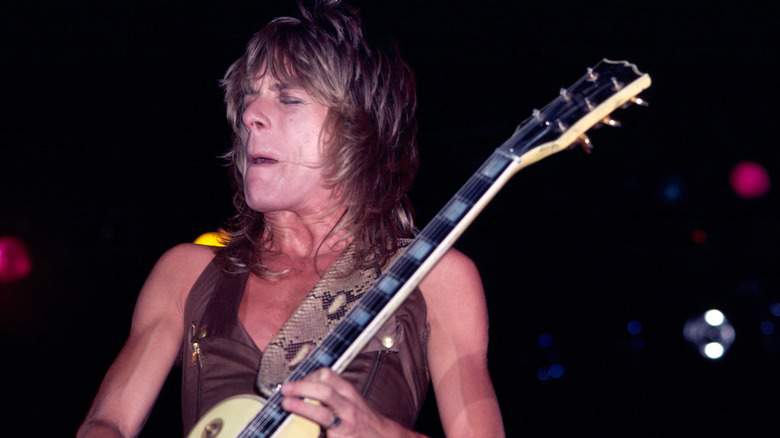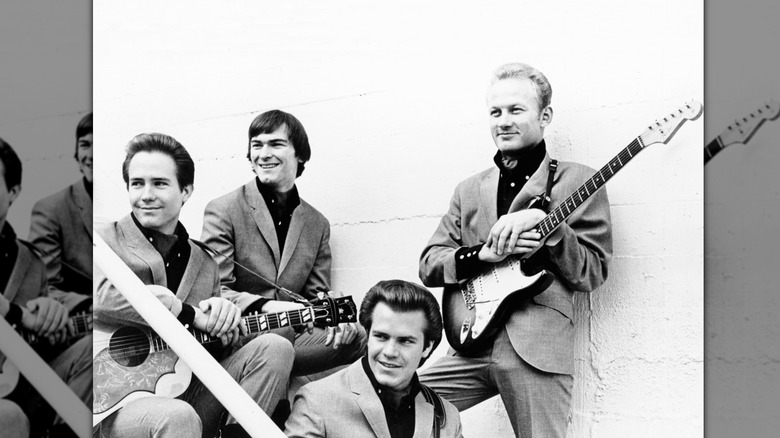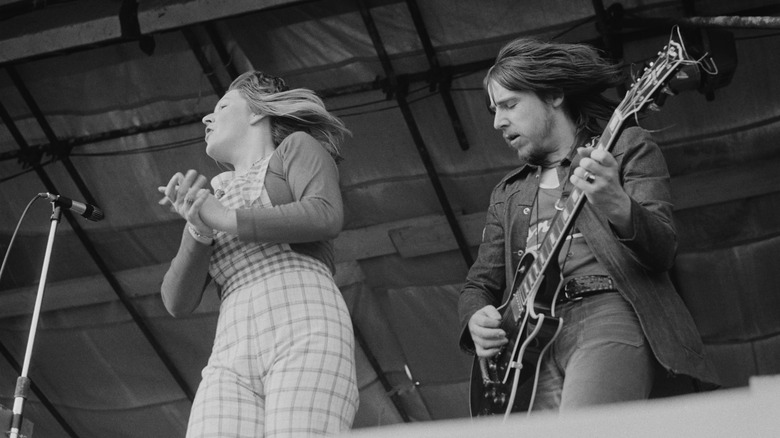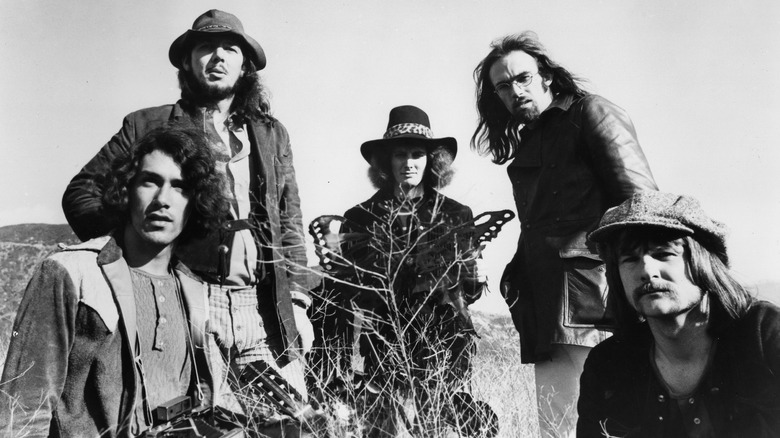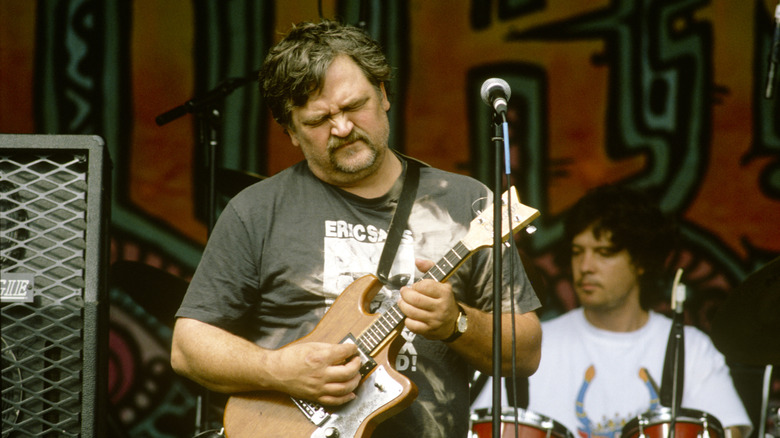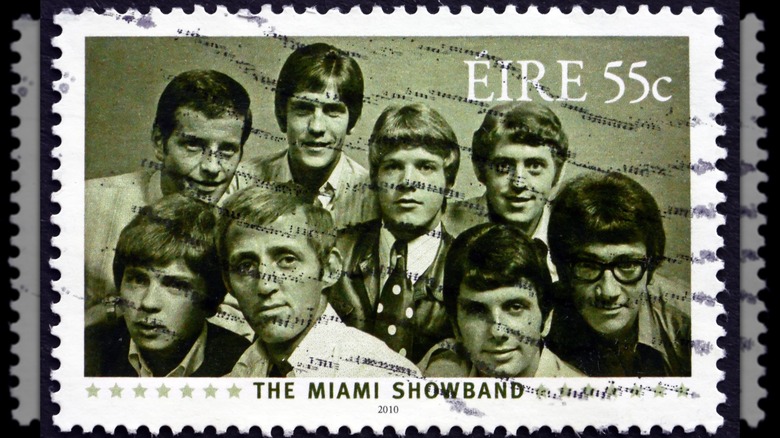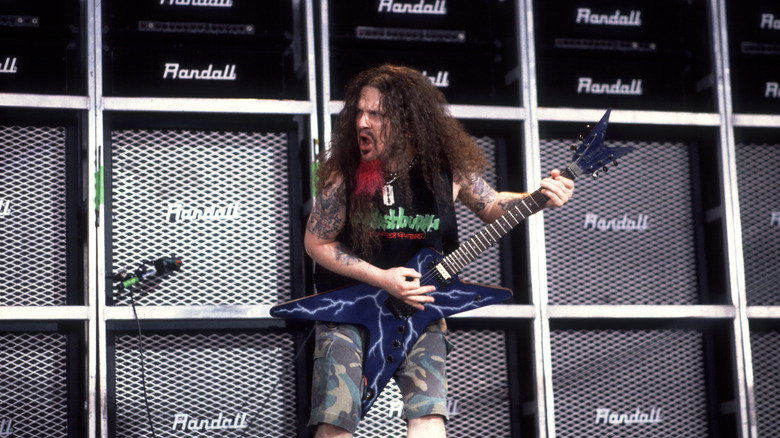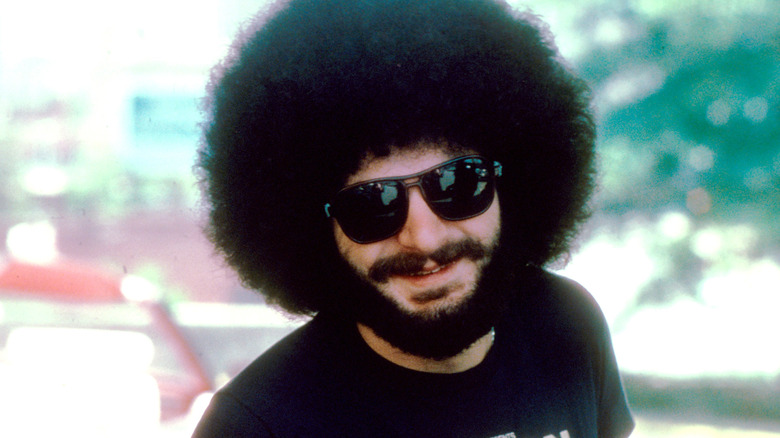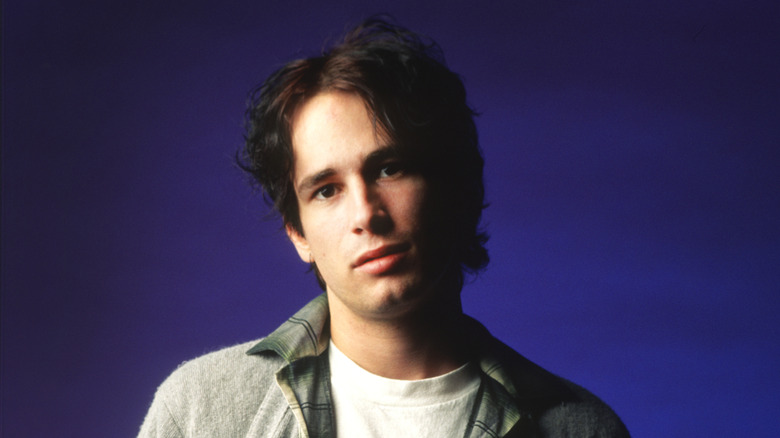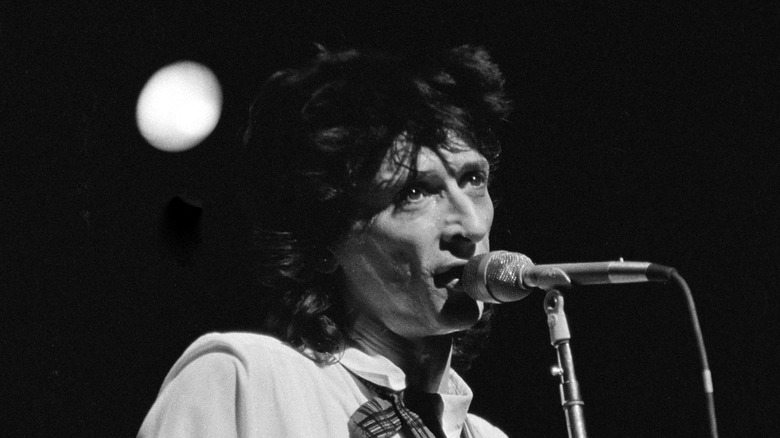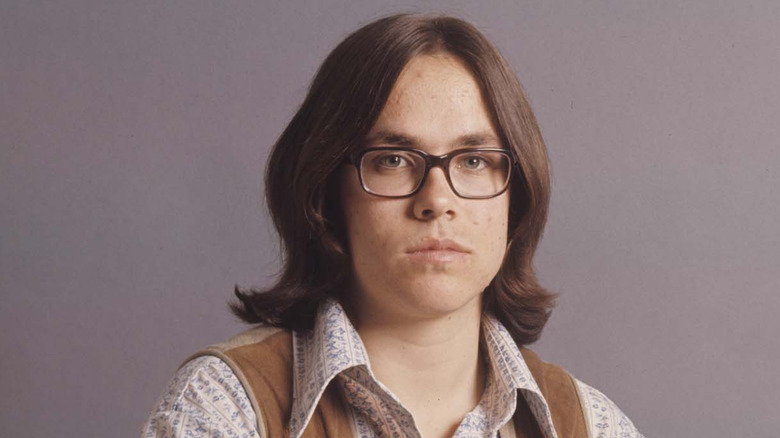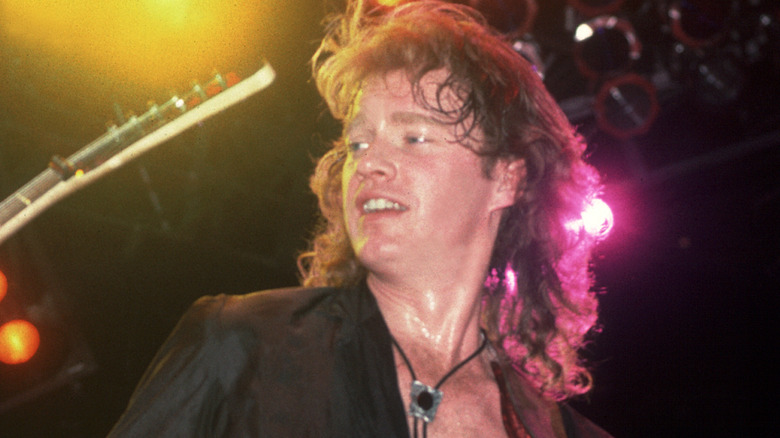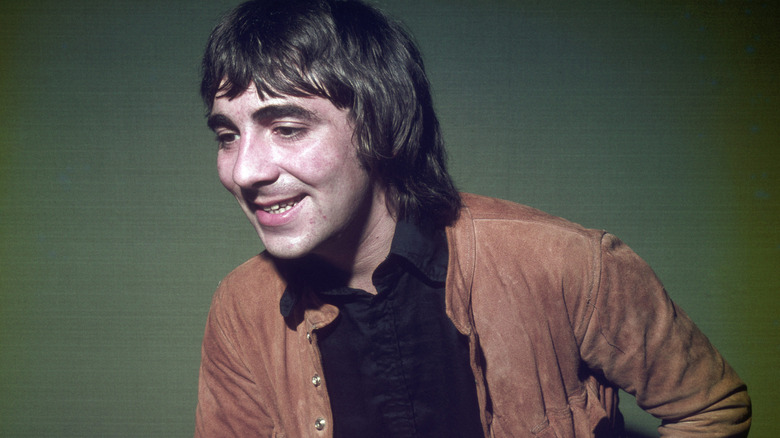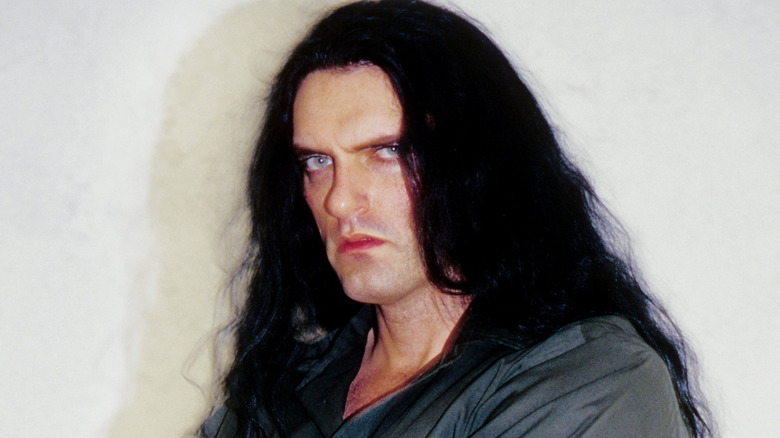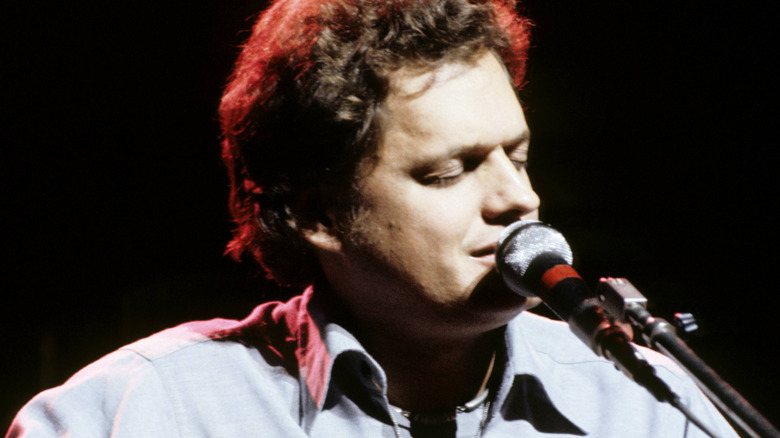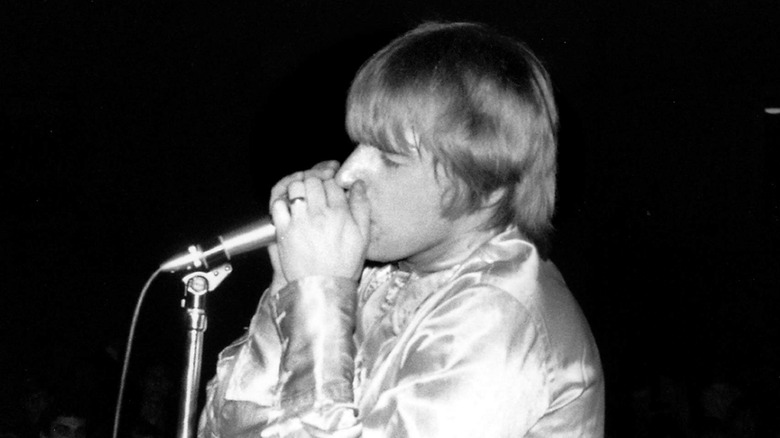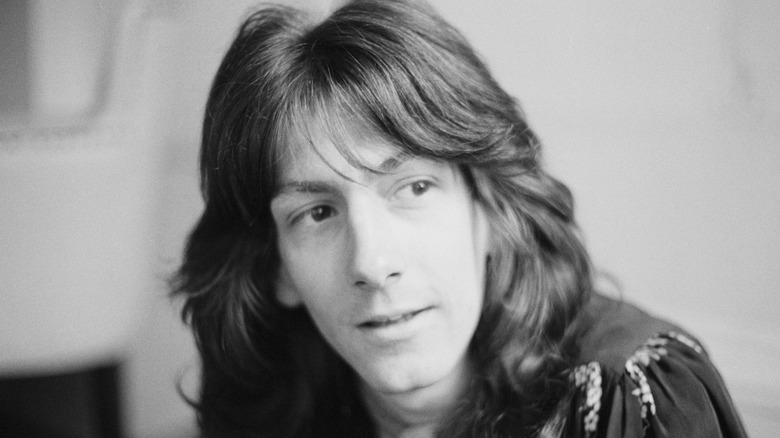The Most Bizarre Rock Star Deaths Ever
As fans of rock stars are well aware, being a great musician, successful, and loved by millions does not necessarily add up to a long life. It's not uncommon for rock stars to die far too young for any number of reasons. What with the type of lifestyle many musicians lead and the pressures of fame, it's not surprising that many times these premature deaths are down to substance abuse or doing not-so-smart things while under the influence. Then there are the tragic accidents or health problems that can befall anyone.
But occasionally, rock stars die in such a way that goes beyond being simply tragic into bizarre territory. These are the deaths that have that one extra detail (or sometimes, many of them) that are just so odd it makes you think about the sad event again and again, wondering just how it could have happened the way it did. Some of the deaths are mysteries that may never be solved, while others seem pretty straightforward at first but get weirder the more you learn about them. And as befits the tragic end of a musician, several even occurred on stage in front of live audiences.
While every death is sad, you have to admit, these ones are also pretty weird. Here are some of the most bizarre rock star deaths ever.
This article contains references to addiction and death by suicide.
Bobby Fuller
Bobby Fuller had been playing music since he was a kid in Texas, and by 1966, he and his band, The Bobby Fuller Four (pictured, with Fuller at far left), had a Top 10 hit with "I Fought the Law." They were famous and going places, although this was marred by annoyance at their manager and his many strange publicity stunt ideas. Otherwise, according to Fuller's loved ones, he was happy.
But on July 18, 1966, Bobby Fuller was found dead in his car, covered in gasoline. He was 23. Witnesses say he had injuries like he'd been in a fight, and that his car hadn't been in the parking lot where it was found just minutes before, even though he had been dead for hours.
If this wasn't weird enough, officials didn't seem to agree on why Fuller ended up dead. While several obituaries in major newspapers implied that he had died by suicide, assumedly getting their information from the police, who clearly felt that was the cause of death, the official report determined it was accidental. But even that wasn't conclusive, as the report also had a question mark next to the box for suicide, the same thing the coroner put by the box for accident. The debate about what happened — suicide, accident, or murder — has raged for decades. Fuller's strange death was even included in the October 18, 1996 broadcast of "Unsolved Mysteries," and although at least one person connected to him contacted the tip line afterward, it remains one of the biggest mysteries in classic rock still unsolved today.
Mike Edwards
A cellist trained at the Royal Academy of Music doesn't sound like your standard rock star. But Mike Edwards was an original member of the Electric Light Orchestra (pictured, with Edwards at far left). He played with them from 1972 to 1975, a period that encompassed four albums and two Top 10 hits on the U.K. charts. Edwards was a big hit with fans, standing out for his kooky outfits and the bits he did on tour where he played the cello with a piece of fruit and pretending to play his cello before it exploded. He eventually left the band but continued to play music.
His death fit right in with his strange ELO stage persona. On September 3, 2010, the 62-year-old was killed in a freak accident, when a 1,300 pound hay bale rolled off a tractor and into a road, where it slammed into Edwards' car, crushing it.
At the time of his death, Edwards was playing with a local group called Devon Baroque. Fellow member Jasper Solomon told BBC News, "Mike's talent was his musicality. He could range over all genres from classical to jazz, modern to medieval renaissance. He lived for his music and it showed." The chairman of the music group, Angus Gordon, said, "He was simply the nicest guy and a brilliant musician. ... He taught the cello and his incredible patience and encouragement – even with the slowest of students – made him a very good teacher."
Terry Kath
When Chicago was inducted into the Rock and Roll Hall of Fame in 2016, original member Terry Kath wasn't there but was not forgotten. "Through the years, his guitar playing has been overlooked," Chicago co-founder Lee Loughnane told the Metro, "Probably because [he was] in such a large band, but if Terry had been in a trio, he probably would have been right up there with Jimi Hendrix, who idolized Terry."
Kath seemed to be aware of this as well, since he was planning on releasing a solo album before he died on January 23, 1978. His friend and fellow musician Joe Walsh told Rolling Stone, "With that [band] dynamic [in Chicago], he needed to do a solo album. I don't know how much of it was recorded, but he was going in that direction. And it's a shame it didn't happen. He would have never remotely thought about suicide. That was a complete accident."
Suicide or accident has always been the question surrounding Kath's bizarre death, one of the biggest rock and roll tragedies of the 1970s. The musician was deep into drugs and also loved guns, which is never a good combination. When he died, he was handling guns — some say cleaning them, others that he was playing Russian Roulette — but reassured the person he was with that they were unloaded. His last words were supposedly, "What do you think I'm going to do? Blow my brains out?" (via Louder). Then the gun went off. Kath was 31 years old.
Les Harvey
Everyone knows there is a long list of stars who died at age 27, but Les Harvey's inclusion on the list has to be one of the strangest (no, not the most shocking — that joke is inappropriate). He was in several bands in the U.K. before joining one called Power — which was renamed one night in 1969 by Led Zeppelin's manager. From then on, the iconic Scottish band was known as Stone the Crows. Their albums are still popular re-releases many decades later.
On May 3, 1972, the group was preparing to perform at a gig in Wales. Some 1,200 people were in the audience, and according to contemporary reporting, some of them decided to take souvenirs in the form of wires out of the band's electronics before they took to the stage. This, of course, caused technical problems, which took time to fix. Harvey came on stage to explain the delay when disaster struck. "We heard this deep humming sound," drummer Collin Allen explained (via Louder). "Leslie had the microphone in one hand and his guitar in the other, they kind of went together, and then like an arc-shape appeared. I was up really quickly and kicked the guitar out of his hand as he was lying on the floor."
The accident was caused because a ground wire to the microphone had not been fixed, and when Harvey touched his metal guitar strings, he closed the circuit. He died a short time later in the hospital, aged 27.
Philip Taylor Kramer
The strange death of Iron Butterfly's Philip Taylor Kramer is one that will keep you up at night. Kramer joined the band (pictured without him in an earlier lineup) in 1974 and played bass on two of their albums. After he left the band, he went on to become a literal rocket scientist, and then an important figure in the booming computer industry of the early 1990s. But on February 12, 1995, he vanished.
Kramer went to pick up a business associate and their partner from the airport, but left before meeting them. Chuck Carter, a private investigator hired by Kramer's family, told the LA Times, "Something happened during that time — either in his head or at the terminal — that made him turn away. And I'll tell you, I haven't a clue. The guy didn't have an enemy. The guy was a dedicated family man." What we do know is that Kramer started calling loved ones to say goodbye. Then he called 911 and announced he was going to kill himself and said, "I want everyone to know O.J. Simpson is innocent. They did it." (The Debrief explains that Kramer was expected to give expert testimony at the trial.)
In 1999, Kramer's van and remains were discovered at the bottom of a canyon. It can't be proven if he died by suicide, and theories of foul play still abound. Some think he might have been threatened over one of his new software programs.
Randy Rhoads
Ozzy Osbourne was already famous when he hired Randy Rhoads as his new guitarist within seconds of meeting him. Rhoads, who had previously been one of the founding members of Quiet Riot, played on some of the most classic Ozzy albums, including "Blizzard of Ozz" and "Diary of a Madman," and most notably the song "Crazy Train." While his accomplishments were enough to see Rhoads inducted into the Rock and Roll Hall of Fame in 2021, sadly, he was only in Ozzy's band for a couple of years before he died.
Randy Rhoads' death is an incredibly tragic story. While on tour, the band's bus stopped for a rest at a lot that held some small planes. The tour bus driver, Andrew Aycock, was also a pilot, and decided to take a couple of flights. The 25-year-old Rhoads, despite being afraid of flying, was a passenger on the final one, along with the band's 58-year-old seamstress Rachel Youngblood. On his previous flights, Aycock had flown close over the tour bus, trying to wake up the people sleeping inside it. On this flight, however, the prank went wrong, and the plane's wing clipped the bus, causing the plane to crash and killing all three of the people inside.
There are other theories on the accident, however. Witnesses say Aycock might have been trying to crash deliberately and Rhoads was attempting to stop him, or that Youngblood had a heart attack and fell on the controls, causing the plane to nosedive. Unfortunately, the true reason will never be known.
Bruce Hampton
The year before he died, "Colonel" Bruce Hampton told Arts ATL, "I never plan anything — good, bad or ugly, I just go with it. I must say that I've always just wanted to play music — not work music, not earn music, just play music and make joyful noise. And I don't know if it's good or bad, but I keep doing it — show up and play." According to CNN, Hampton was known as the "granddaddy of the jam scene," and the respect other musicians had for him was clear by how many showed up to jam with him at his 70th birthday concert on 2017.
It was the very end of the performance when Hampton dropped to his knees, then laid on the stage. The audience just thought he was playing around, as did the other musicians, who kept playing as Hampton lay there, suffering a massive heart attack. It took several minutes for anyone to realize something was very wrong. Hampton isn't the only performer to die in front of their audience, but he is probably the only one who died during their own birthday party.
According to his friends, it's exactly what Hampton would have wanted. Rolling Stone keyboardist Chuck Leavell, who was on stage with Hampton at the time, said (via CNN), "A poetic exit. And I'm sure if he had written the script himself, that would've been the last page of the last chapter." And Hampton's former bandmate Jeff Mosier posted on Facebook (via NPR) that he "could have never imagined a more joyful departure."
Three members of the Miami Showband
In the U.S., "the day the music died" was the plane crash that killed Buddy Holly, Richie Valens, and the Big Bopper. But in Ireland and Northern Ireland, that phrase refers to July 31, 1975, when three members of the popular group The Miami Showband were murdered. Showbands were huge on the island at the time; they would travel around playing concerts and regularly cross the border between Ireland and Northern Ireland (which is part of the United Kingdom). But this was the 1970s, smack in the middle of the sectarian violence known as The Troubles.
When the band van was pulled over, they thought it was a checkpoint, a common occurance at the time. What they didn't know was it was a fake Army patrol made up of Ulster Defence Regiment and Ulster Volunteer Force members. What took the event from purely tragic to bizarre is that the Ulster men didn't plan on killing the band — the goal was to place a bomb on their bus that would explode once they were across the border in Ireland. But it exploded while it was being attached, killing two of the Ulster men. The remaining ones then started shooting at the band, killing three of them: lead singer Fran O'Toole, guitarist Tony Geraghty, and trumpeter Brian McCoy. Two other members were injured but survived the massacre.
The incident effectively put an end to Irish showbands crossing the border to play in Northern Ireland.
'Dimebag' Darrell Abbott
"Dimebag" Darrell Abbott was a founding member of Pantera, the incredibly popular metal band. They formed in 1981, but in the 21st century, the band split up and Abbott started a new band, Damageplan.
In 2004, Damageplan was playing a gig in Cincinnati, Ohio, when a man named Nathan Gale jumped on stage. He damaged thousands of dollars in equipment and fought with security before being removed. The police were called, but no charges were filed because the band thought it would be too inconvenient to return for the court date.
Eight months later, Gale showed up at another Damageplan concert in Ohio, this time in Columbus. Some people present noticed him as soon as he entered the venue from a side entrance and raced towards the stage. "The dude was way determined," said Volume Dealer lead singer Billy Payne (via Rolling Stone). "He was on a mission. He looked angry. He was walking like he was going into battle." Gale got on stage, pulled out a gun, and confronted Abbott. Joe Dameron, Volume Dealer's bass player, said, "I saw him open his mouth to yell something, but I don't know what it was. He just looked determined." Gale shot Abbott, but at first, it wasn't clear how serious the situation was. Security guard Ryan Melchiore said, "I thought they were playing a big gimmick. People were pumping their fists, thinking it was a hoax." When people finally started to intervene, Gale shot and killed three of them. Abbott did not make it either. He was 38.
Sib Hashian
John Thomas Hashian went by the name Sib, and in the 1970s he played on two of the best-selling rock albums of the decade. He was the original drummer for Boston, and he kept the beat all over the band's 17-million-selling self-titled debut and its 7-million-selling follow-up, "Don't Look Back." Hashian also played drums on Boston guitarist Barry Goudreau's self-titled 1980 solo record, but slowly retreated from music, taking on acting work, starting some businesses, and helping his daughter Lauren start a pop career.
In 2017, Hashian made a welcome return to the classic rock scene, taking a spot behind the drums as a member of the house band on the Legends of Rock theme cruise. The temporary supergroup also included Lou Gramm of Foreigner, David Marks of the Beach Boys, and John Elefante of Kansas. Hashian was doing what he loved to do, drumming, when he died. While playing, Hashian lost consciousness and slumped over. Removed from the stage, he was pronounced dead by the cruise ship's doctor. He was 67 years old.
Jeff Buckley
Jeff Buckley so startled the music world in 1994 and 1995 that it looked like the powerfully-voiced singer-songwriter of haunting originals like "Grace" and "Last Goodbye," as well as a cover of Leonard Cohen's beloved "Hallelujah," would be around and making records for a very long time. Named one of the best new artists of the year by Rolling Stone and the MTV Video Music Awards in 1995, Buckley completed just one studio album, "Grace."
In 1997, Buckley decamped to Memphis to record what would have been his second album, "My Sweetheart the Drunk." On the night of May 29, 1997, Buckley was entertaining a friend when he decided to go for a swim in the Mississippi River. Buckley curiously, alarmingly, and unwisely headed into the river with all of his clothes on. Already weighed down by his wet clothes, a powerful wave from a passing boat pulled the musician below the surface and he wasn't able to get back to safety. About a week later, Buckley's body was found. The musician died from drowning at the age of 28.
Johnny Thunders
When the New York Dolls first started playing gigs around New York City in the early 1970s, its members wore garish makeup and played rock that was confrontational as well as melodic. The band became cult figures in New York, known to send its club audiences into a frenzy, and by the time it broke up in the mid-1970s, it had influenced the rise of both glam rock and punk. The main force behind the messy, shambolic juggernaut that was the New York Dolls was guitarist John Genzale, aka Johnny Thunders.
In the early 1990s, Thunders toured Japan, where he was a very popular live act, and then settled into New Orleans to record an album. On April 23, 1991, the body of Thunders was found in his rented apartment, stuffed under a table with his limbs twisted. According to Thunders' bandmate Stevie Klasson, Thunders had been partying hard the night before with friends who swiped the guitarist's supply of methadone (used therapeutically to treat heroin addiction), then gave him a large dose of LSD and killed him.
However, according to an autopsy conducted by the Orleans Parish Coroner's Office, Thunders died at 38 of an overdose of cocaine and methadone, as both drugs were prominent in the musician's system. Additionally, the coroner noticed that Thunders had leukemia, a cancer of the blood and bone marrow. He'd received his diagnosis four years earlier, but hadn't sought medical treatment for it.
Jeff Porcaro
Toto was among the most successful acts of the late 1970s and early 1980s, charming and soothing the masses with its laid-back and sonically precise soft rock. Formed and headed up by drummer Jeff Porcaro, Toto was made up of some of the most experienced session musicians of the era, and that professionalism can be heard in hits like "Africa" and "Rosanna," both spawned from the LP "Toto IV," which won the band the Grammy for Album of the Year.
In August 1992, while doing some yard work at his home in San Fernando Valley, California, Porcaro suddenly felt extremely ill, and by the time paramedics arrived, he'd lost consciousness, and his breathing and heartbeat had ceased. Airlifted to a hospital, Porcaro was unable to be resuscitated and was pronounced dead at the age of 38. Porcaro definitely died of a heart attack, a medical truth made immediately clear in the emergency situation, but the attending physicians initially believed that the musician's heart stopped working as a symptom of an allergic reaction to the pesticides Porcaro had been using on his plants. An autopsy showed no signs of pesticides, and it seemed as if hardened arteries were responsible for the cardiac event, a condition that presents in patients with a history of long-term, voluminous cocaine use. Oddly, only trace amounts of cocaine could be found in Porcaro's system.
Scott Smith
Two of the biggest new sounds of the late 1970s were guitar-driven arena rock and catchy, crunchy, keyboard-laden New Wave. One of the hottest bands of the early 1980s, Loverboy, put those two sensibilities together and scored a string of hit singles. Among the Loverboy songs that still get played on rock radio 40 years later are "Hot Girls in Love," "When it's Over," "Turn Me Loose," and "Working for the Weekend." There's a lot of melodic, assertive low end on Loverboy's songs, and that was provided by Loverboy bassist Scott Smith.
On November 30, 2000, after Loverboy played at a benefit for a juvenile diabetes charity in Vancouver, British Columbia, Smith and three cohorts departed the coastal city on the bassist's 37-foot sailboat, planning to ride the Pacific Ocean all the way down to Mexico. But as the boat neared San Francisco, rough and rocky weather created 20-foot-tall waves that beat down upon the ship. One wave tossed Smith off the deck of his boat and into the water. Almost immediately, he disappeared, and none of Smith's sailing party could locate him, nor could helicopters sent by the Coast Guard, two rescue boats, or a private search funded by the musician's family. Smith presumably died at sea at the age of 45, although his remains were never recovered.
Keith Moon
Known almost as much for his hard-partying ways as he was for his thunderous work sitting behind the drum kit for the loud and heavy The Who in the 1960s and 1970s, Keith Moon tried to get clean. "I'm quite out of control," Moon declared in an otherwise fluffy "Good Morning America" interview (via Rolling Stone) in 1978. Seeking to get his alcohol consumption under control, Moon took the medical route and a doctor prescribed Heminevrin (clomethiazole), which helps severe alcoholics by suppressing the painful and overwhelming withdrawal symptoms that can occur when limiting alcohol intake. In a tragic and ironic twist, it's the Heminevrin that killed Moon.
On September 6, 1978, Moon attended a party held by Paul McCartney, and he abided by a rule he set for himself that he would only drink two glasses of champagne. When he returned home, Moon ate a meal, gave himself a large dose of Heminevrin, and fell asleep at about 4 a.m. He awoke at 7:30 a.m., consumed another meal and pills, fell asleep, and never woke up. On the evening of September 7, Moon was pronounced dead at the age of 31. Over the span of his last night alive, Moon had ingested in excess of 30 Heminevrin tablets, and the drug had shuttered his esophagus, preventing the musician from vomiting. As a result, Moon died from asphyxiation while he was asleep.
Peter Steele
Perhaps the quintessential dark metal band, Type O Negative's music was so concerned with death, pain, sadness, and doom, and it was delivered in such a low, dreary, and foreboding drone, that it veered into humorous and intentional self-parody at times. Such was the precise mixture created and unleashed by Type O Negative's almost impossibly deep-voiced — and intimidatingly tall — lead singer Peter Steele.
In April 2010, just about five years after Type O Negative perpetuated a hoax that Steele had died, around the time that he'd checked into a drug rehab facility and then a mental health institution to address issues with substance misuse and mental health issues, respectively, Steele passed away for real. "Peter passed away last night. As of now it appears to have been heart failure," band manager Mike Renault told CBS News. A post-mortem medical investigation discovered that Steele hadn't died of heart failure, but rather sepsis, which can occur when the body's immune system overreacts to an infection. This can cause irreversible damage to organs, which then leads to an overall shutdown and death. The infection that had caused Steele's sepsis was diverticulitis, an inflammation of the large intestine. The singer was 48 years old.
Harry Chapin
A guitar-toting singer-songwriter, Harry Chapin made music about human connection and healing. In the early 1970s, he routinely hit the charts with his gentle compositions, including "Taxi," "Sunday Morning Sunshine," and "I Wanna Learn a Love Song," as well as the devastating bad-dad takedown and No. 1 smash, "Cat's in the Cradle."
Shortly after noon on July 16, 1981, Chapin was driving his 1975 Volkswagen on the Long Island Expressway, just outside the town of Jericho, New York. With his hazard lights turned on and flashing, Chapin's vehicle changed lanes, at which point it was hit from the rear by a flatbed truck at 55 miles per hour. After the crushed car came to a halt, its gas tank caught fire; the driver of the truck, Robert Eggleton, cut Chapin out of his seatbelt and pulled him to safety as the car became engulfed in flames. About half an hour later, Chapin was declared dead at a hospital, after doctors were unable to restore consciousness. The singer was 38 years old. The exact cause was unclear: While there was evidence that an artery was pulled away from Chapin's heart upon impact, medical staff worked for 30 minutes treating a cardiac arrest. It's possible that Chapin had a heart attack while driving before the accident even occurred.
Keith Relf
The Yardbirds contributed electric, bluesy rock sounds to the British Invasion scene of the mid-1960s. While the group was only intact for five years, it helped launch the careers of influential classic rock guitarists Jimmy Page, Eric Clapton, and Jeff Beck. It was formed by singer, songwriter, and harmonica player Keith Relf, who conceived, put together, and fronted the operation that is best known for "Heart Full of Soul" and "For Your Love." After the Yardbirds split up in 1968, he continued playing guitar for the bands Together, Renaissance, and Armageddon.
It was while he was practicing that instrument in the basement of his London home in May 1976 when he suddenly died in a strange accident. Relf's guitar hadn't been properly electrically grounded. That can lead to electrical currents surging into the person playing the instrument, and that's what happened to Relf. He was electrocuted and instantly died on the spot at the age of 33.
Randy California
Spirit's sensibilities were all over the place, fusing rock with jazz, classical, blues, and other styles to create a truly progressive form of progressive rock across the 11 albums it released in the late 1960s and 1970s. On lead vocals and guitar was Randy Wolf, who went by Randy California after picking up the stage name from his former collaborator, Jimi Hendrix. California also played guitar with Deep Purple for a little while during the run of Spirit, a band best known for writing and recording "Taurus," a 1968 album cut so similar to Led Zeppelin's "Stairway to Heaven" that lawsuits were filed.
Over the 1997 New Year's holiday, California took a vacation to the Hawaiian island of Molokai with his family. While swimming near an ocean beach, California and his 12-year-old son were quickly and violently pulled below the water by a large wave they didn't expect. The guitarist was able to pull his child out of the riptide and help him get to safety, but he was swept out to sea during the life-saving act. California was 45 years old at the time of his presumed death; his body never materialized.
Steve Peregrin Took
T. Rex took off in the 1970s as one of the major glam rock acts, churning out groovy, hard-charging hits like "20th Century Boy" and "Get It On (Bang a Gong)." But before all that, it was a '60s duo made up of singer Marc Bolan and multi-instrumentalist Steve Peregrin Took. Taking two-thirds of that stage name from a hobbit in "The Lord of the Rings," the musician born Stephen Porter's drug use and insistence on making Bolan perform songs he'd written led to his contentious exit from his own combo in 1969. Took spent the '70s performing with a series of moderately successful bands, such as the Pink Fairies.
On October 27, 1980, Took died at his home in London at the age of 31. The official cause of death, according to an autopsy, was that he choked to death on a small cocktail cherry, also known as a Maraschino cherry. Took had been under the influence of drugs at the time of his death, having taken hallucinogenic substances and morphine the night prior to his death, but the coroner didn't believe that those had anything to do with the musician's demise.
Josh Martin
While maybe not a household name in the general music or classic rock communities, Josh Martin was a well-known and important figure in the extremely dark, remarkably loud, and very quickly played subgenre of heavy metal called grindcore. The guitarist absolutely shredded in the 1990s and 2000s as a member of such bands with colorful names like Failure Clinic, Impaled Northern Moonfest, and Adolf Satan.
On Memorial Day 2018, Martin went to the Providence Place Mall, a large shopping center in Rhode Island. According to a police report obtained by WPRI-TV, just before 11 p.m., an adult male who was later identified as Martin was seen "clowning around" on an escalator, which included riding along the rail of the people-moving device. Then Martin lost his balance and fell off the escalator from about a second-story height, into the food court. "It's quite a big drop," David Lapatin of the Providence Police Department told WPRI. "Anybody who has been to the Providence Place Mall in the food court, you see the two escalators going up to the movie theater and Dave & Buster's, you know how high that is." The head injury Martin suffered proved deadly, and he died at the age of 45.
If you or anyone you know needs help with addiction issues, is struggling or in crisis, contact the relevant resources below:
-
The Substance Abuse and Mental Health Services Administration website or contact SAMHSA's National Helpline at 1-800-662-HELP (4357).
-
Call or text 988 or chat 988lifeline.org
